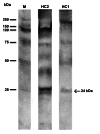Anisakiasis and gastroallergic reactions associated with Anisakis pegreffii infection, Italy
- PMID: 23621984
- PMCID: PMC3647659
- DOI: 10.3201/eid1903.121017
Anisakiasis and gastroallergic reactions associated with Anisakis pegreffii infection, Italy
Abstract
Human cases of gastric anisakiasis caused by the zoonotic parasite Anisakis pegreffii are increasing in Italy. The disease is caused by ingestion of larval nematodes in lightly cooked or raw seafood. Because symptoms are vague and serodiagnosis is difficult, the disease is often misdiagnosed and cases are understimated.
Keywords: Anisakis pegreffii; allergic reaction; anisakiasis; gastroallergic anisakiasis; helminth antigens; molecular diagnostic techniques; parasite; sequences analysis DNA; zoonoses; zoonosis.
Figures


References
-
- D’Amelio S, Mathiopoulos KD, Brandonisio O, Lucarelli G, Doronzo F, Paggi L. Diagnosis of a case of gastric anisakidosis by PCR-based restriction fragment length polymorphism analysis. Parassitologia. 1999;41:591–3 . - PubMed
MeSH terms
Substances
LinkOut - more resources
Full Text Sources
Other Literature Sources
